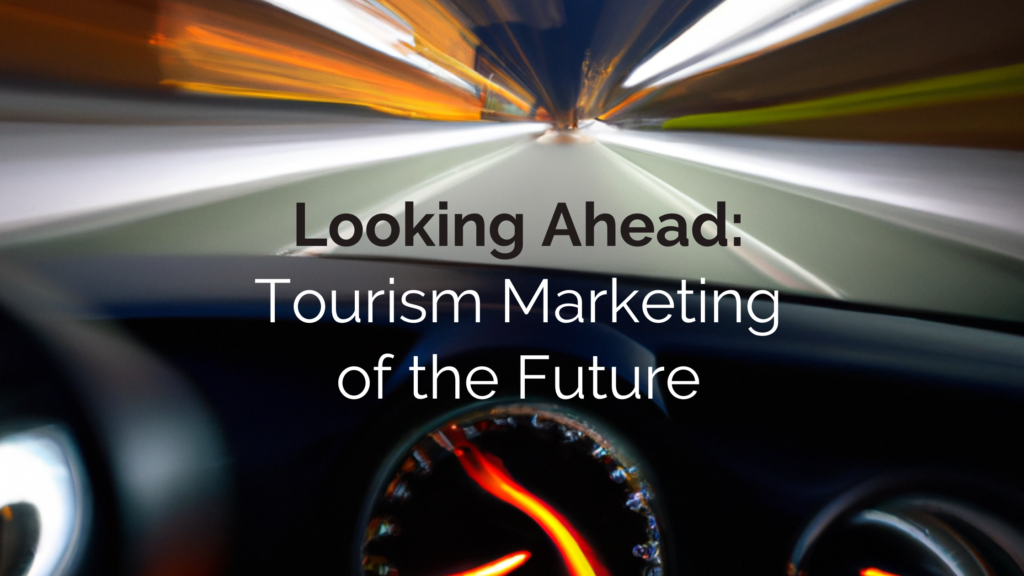Looking Ahead: Tourism Marketing of the Future
Last week, I attended the Marketing Profs B2B Forum and it felt like a glimpse into the shiny future of marketing. In the not-so-distant future, tech tools will be speeding our work along like the moving sidewalks at an airport. I came away from the conference energized and ready to experiment with so many ideas, from branding and DEI to AI and Web3. These concepts, both the new and the familiar, are all part of tourism marketing of the future.

Artificial Intelligence
is Going to Change Everything. Paul Roetzer of Marketing AI Institute gave a keynote on marketing AI. “It’s just smarter tech,” he told us, and “you’re already using AI as a consumer.” It’s not as seamless in marketing, but the tools are progressing fast. In fact, he told us that AI writing tools are improving 2x every 6 months.
Artificial Intelligence tools are defined as going beyond machine learning, to deep learning and prediction. I loved his recommendation to look for opportunities to use AI to:
- personalize experiences
- intelligently automate
- enhance creativity
Those are certainly elements I’m comfortable with becoming part of tourism marketing of the future. Artificial intelligence (AI) can change everything about marketing, from the way we create content to the way we target and personalize messages. If you’re not already using AI in your marketing, now is the time to start experimenting. Here are a couple ways you can use AI in your marketing:
Image Generation
Dall.E and similar sites create images using AI and simple text commands. It won’t work for everything, and certainly can’t take the place of photos of your destination, but it can do better than a free stock photo. Below is an image I created with an experiment to use for a social post asking for testimonials for the Apple Tasting Tour. I searched for an image of a “heart-shaped apple floating in front of an apple orchard in fall.” It took a few tries, but we liked this result:

Content Generation
Anyone who’s used the swipe-to-fill feature on a smartphone has used AI content generation. I used AI to help me write this blog (a tool called Jasper). Not this sentence, but a few of them. It helped me figure out a title and even got me started on a few paragraphs.
Someday, will these tools write real and meaningful content? Will they connect with an audience? I have my doubts. How much can a computer “learn” about a destination? I don’t think artificial intelligence can replace human thought in tourism marketing, but I don’t mind trying it out to give us a head start on everything we want to do. Perhaps it’s a tool to enhance creativity or intelligently automate.
There are also AI-powered tools that can help with email marketing, customer segmentation and website design.
Branding
Brand Voice Is More Important Than Ever. That was my main takeaway from Ann Handley’s (CCO of Marketing Profs) welcoming remarks! She said it’s “the new logo” and conveys personality as a brand. Even though her talk was targeted to business-to-business marketers, she borrowed examples from B2C brands like Wendy’s and DuoLingo. Consumers like authenticity and fun – and a brand voice is a great way to communicate emotion and culture. So often, we fall into a “sea of sameness” when writing about travel. What can we do to step away from the conventional and be memorable?
My top tips from this session:
- Use short sentences
- Take out buzzwords
- Inject emotion
- Help voice reflect culture
- Convey personality
Diversity, Equity & Inclusion
Sydni Craig-Hart of Smart Simple Marketing led a session on Inclusive Strategies. DEI is certainly at the forefront of professional development, and she did mention investing in training to diversify your perspective. Her other tips included:
“Expand your network internally & externally, intentionally. Build relationships with people who have different perspectives.”
Supply chain diversity is also important to consider. Even if you’re not hiring at the moment, you can diversify who you do business with. “A supply chain that incorporates small business owned by diverse individuals to empower economic equality and invite perspective.”
My favorite takeaway from Sydni Craig-Hart’s session was “We can’t have equity without empathy. Don’t wait to figure it all out or get your ducks in a row – Start applying it today!”
Web3 & The Blockchain
The future of marketing is being shaped by Web3 technologies like the blockchain. These technologies are changing the way we interact with customers at varying levels. In a lunch session, Tony Pham of SuperLayer explored the concept of Web3 for marketing, but honestly it is all going over my head still. It reminds me of when people started talking about “the cloud.” I did not know what this cloud thing was, what it did, or how to use it. Now it’s part of my everyday tasks! Hopefully with more learning and experimenting, Web3 and Blockchains will become more clear. Until then, I like the way Web3 is defined in this article from AdAge:
“Web3 aims to put people before corporations. It’s user-first, democratized and lets people control their own data. Web3 still has advertising, but it’s based on trust and consent. With Web3, users can make their own choices about tracking, cookies and how they want their data used.”
What does this mean for tourism marketers? We need to focus on the user experience and making sure that we are transparent about how we use data. We also need to make sure that we are providing value to the user, whether that be through great content, amazing customer service, or unique experiences.
Tom Pham gave examples of Web3, some elements are recognizable as experts say we’ve left Web 2.0 for a transitionary Web 2.5. Others are completely new concepts.
- NFTs (non fungible tokens – I had to look it up, too)
- Cryptocurrency
- Meme videos
- QR Codes
- The Metaverse
- Twitter Spaces
- Ethereum domains
The Future of Marketing
The future of marketing is the same as the past: all about the consumer. Now we’re using data to create personalized experiences that are valuable to the customer. We’re being transparent and authentic and inclusive while providing value to them. Marketing will also continue to evolve as new technologies emerge, so it’s important to stay up-to-date on the latest trends. By now, the crystal ball is taking shape with these future marketing elements, 2023 tourism trends and an outlook on the DMO of the future.
(Dying to know what’s AI in this blog? Check out my “answer key” below)
Author
Related Posts
How Curated Experiences Can Help Your Tourism Marketing
In years past, travelers may have been satisfied to see sites like the Eiffel Tower or Colosseum; now they want to get behind the scenes,...
Marketing for Group Travel: Building Solid Relationships with Tour Operators
Group travel is a significant segment of the tourism market, and if you want to see those buses pulling up to the curb and filling…
